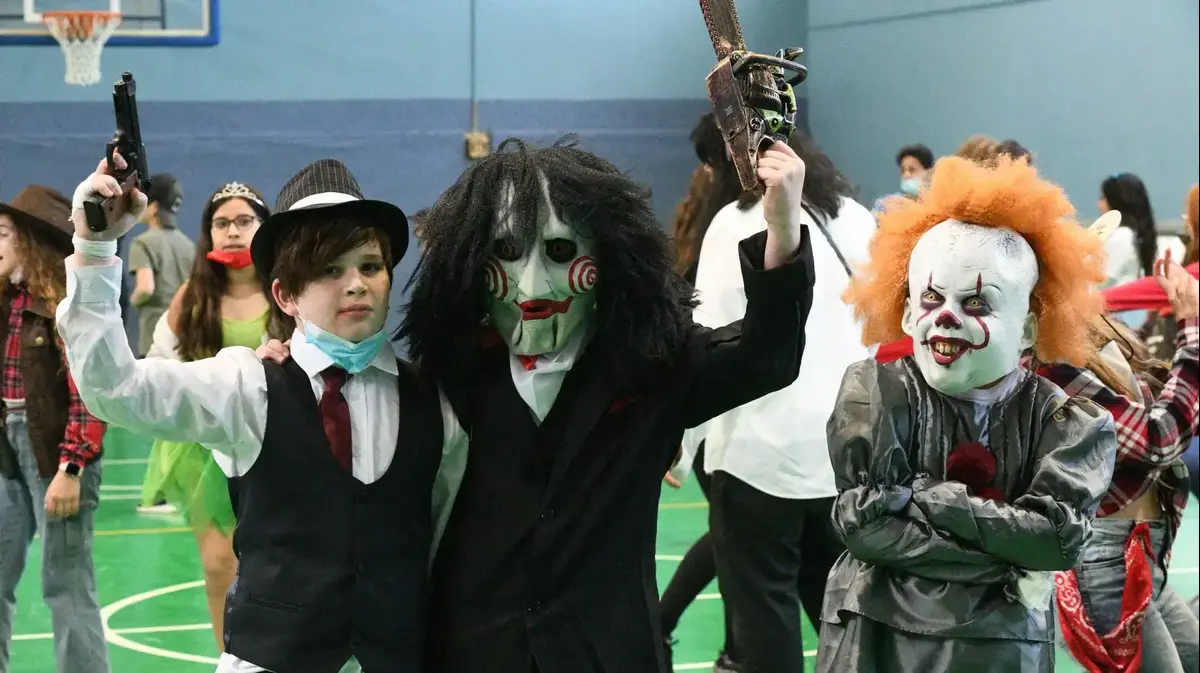When Adam Lane became principal of the Haines City high school eight years ago, there was little chance of stopping an attacker from entering the high school, which sits next to orange groves, a cattle farm and a cemetery in central Florida.
"You could drive up and walk right into the office," Lane says.
Currently, the school is surrounded by a
3 meter fence
and access to the premises is carefully controlled through specific gates.
Members of the Fountain Police Department participate in an Active Shooter Response Training exercise at Fountain Middle School in Fountain, Colorado.
(Dougal Brownlie/The Gazette via AP, File)
Visitors must press a buzzer to enter the main office.
More than 40 cameras monitor key areas.
New federal data released Thursday offers a glimpse of the many ways schools have tightened security over the past five years, with the country recording three of the deadliest shootings on record and the that other
routine
firearms incidents on school grounds
have also become more frequent .
About two-thirds of public schools in the United States now control access to the school grounds - not just the building - during the school day, up from about half in the 2017-18 school year.
An estimated 43% of public schools have a "panic button" or silent alarm that connects directly to the police in an emergency, up from 29% five years ago.
And a stronger majority, 78%, equip classrooms with
locks,
compared with 65%, according to survey data released by the National Center for Education Statistics, a research arm of the US Department of Education.
Showing how much safety is part of normal school life, almost a third of public schools reported holding evacuation drills
nine or more times a year.
Some of the practices that have sparked the most debate have also increased, but are less widespread.
Random use of metal detectors was recorded in 9% of public centers, while daily use was recorded in 6%.
And while many schools have police on campus, only 3% of public schools reported arming teachers or other non-security employees.
The data was collected in a survey carried out in November in more than
1,000 public centers.
Despite the fact that schools spend billions of dollars on security, the number of firearms incidents in schools has only grown.
The latest tragedy occurred last week in
Virginia,
where police said a
6-year-old
first grader brought a gun from home and used it to seriously injure his teacher.
Last year, more than 330 people were fatally shot or injured on school grounds, up from 218 in 2018, according to the K-12 School Shooting Database, a research project that tracks cases of shoots or brandishes a weapon on school property.
The total number of incidents -- which can include cases where no one was hurt -- also rose to more than 300, up from about 120 in 2018, and as low as 22 in 1999, the year of the
Columbine
High School shooting , when two teenagers killed 13 people.
The uptick in gun violence in schools comes amid a broader rise in active shooter incidents and gun deaths in the United States.
In general, the schools are still quite safe.
School shootings are "
very, very rare
," says David Riedman, founder of the K-12 School Shooting Database.
Its tracker identified 300 schools with firearms incidents last year, a small fraction of the nearly 130,000 schools in the United States.
School shootings account for less than 1% of the total firearm deaths suffered by American children.
However, the growing number of victims has placed the responsibility on schools not only to educate, feed and counsel children, but also to protect them from harm.
Best practices include simple solutions like locking classroom doors and limiting access to schools.
But experts say that many "deterrent" measures - such as metal detectors, transparent backpacks or the presence of armed personnel on campus - have not been shown to reliably prevent shootings.
Other tools, such as security cameras or panic buttons, can help stop violence in the moment, but are unlikely to prevent shootings.
"There's not a lot of evidence that they work," says Marc Zimmerman, co-director of the National Center for School Safety at the University of Michigan, referring to many of the security measures.
"If
a panic button
is pushed , it probably means someone is already shooting or threatening to shoot. That's not prevention."
Increasing security can also carry its own risks.
A recent study found that black students are four times more likely than other races to be enrolled in schools with high surveillance and that students in those schools may pay a "safety tax" on academic results and failures due to these measures. .
The most effective time to stop a school shooting, according to experts, is before a weapon arrives on campus.
Since most school shootings are the work of current or recent students, their peers are often the best people to warn and report a threat, says Frank Straub, director of the National Policing Institute's Center for Targeted Violence Prevention, which studies school shootings averted.
"Many of these people participate in what is called a leak:
They post it on the internet and tell a friend about it," explains Straub.
She added that teachers, parents and others should also be on the lookout for signs:
a child who becomes withdrawn and depressed, a student who draws weapons in a notebook.
"Fundamentally, we have to do a better job of recognizing K-12 students who are struggling," he said.
"And that's expensive. It's very difficult to prove what has been prevented."
However, most school shootings are not planned mass attacks.
"The most common thing - throughout history and in the last two years, in which there has been a spectacular increase - is that there are fights that end in shootings," explained Riedman, of the Database of Shootings in K-12 Schools (K-12 School Shooting Database).
Pointing to the rise in shootings across the country, Riedman said the data suggests more and
more people,
including adults, are bringing guns to school.
Christi Barrett, superintendent of the Hemet Unified School District in Southern California, knows that no matter what she does, she cannot completely eliminate the possibility of risk to every one of the 22,000 students and thousands of employees in her sprawling district. covering 28 schools and nearly 1,800 square kilometers.
But it has worked to be proactive, starting several years ago with a closed door policy in all classrooms.
The district is also in the midst of transitioning to the use of electronic locks, which it hopes will reduce any "human variables" or fuss with keys in a crisis.
"If there's an intruder, an active shooter, we have the ability to
lock everything down
instantly," he said.
School authorities had also launched occasional, random pat-downs with metal detectors at some schools, with mixed results.
The devices sometimes detected harmless objects, such as school folders, while failing to detect weapons when not in use.
And while she said the searches weren't focused on any one group, she acknowledged that there was general concern about the disparate impact school policing can have on students of color.
"Even being random, that perception can be there," said Barrett, whose district is majority Hispanic, with smaller populations of black and white students.
A more universal system is now available to all secondary and high schools in the district, designed to specifically detect the metal of firearms.
"All the students go through it," he said, adding that
no
.
To deal with the mental health of the students, he said, there are counselors in all the centers.
And a computer program alerts when a student types trigger words -- such as "suicide" or "shooting" -- into district-provided devices to better identify kids who need help.
He said the terrifying mass shootings at schools in recent years - in Parkland, Florida;
Santa Fe, Texas;
and Uvalde, Texas - did not push for security improvements as much as reaffirm them.
"It was more of a reinforcement of: 'Let's not be lax,'" he said.
c.2023 The New York Times Company
look also
What explains the mass shootings in the United States?
International comparisons suggest an answer: weapons
At least six injured in a shooting at an Oakland high school









